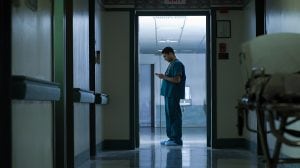April 25, 2022
Your internet browser isn't supported.
We were taught in school that humans need food, water, air, and shelter to survive. Some would add light to that list. There’s growing evidence that light can be used to positively affect one’s mood, energy, and overall mental and physical health.
Human-Centric Lighting has many benefits for healthcare facilities, including – and perhaps surprisingly – cost savings over traditional lighting as well as cost savings from reduced employee sick days.1
What’s the science behind Human-Centric Lighting?
In 2017, two scientists were awarded the Nobel Prize for, among other things, confirming that we all have an inner clock (also called circadian rhythm) that responds to 24-hour cycles of light.2
For example, morning daylight emits a bright bluish cool light that’s been proved to suppress melatonin, i.e., the natural hormone that our brains produce as a sleep aid. But as evening approaches, daylight slowly changes to a warm yellow light that allows the production of melatonin to commence and ready us for our overnight sleep cycle. (The effects of warm and cool colors are sometimes referred to as color temperature.)
Healthcare environments can be disruptive to the human internal clock.
In hospitals, bright lights and constant staff activity interrupt patients’ natural sleep cycles.
Many patients and staff spend their day too far away from windows to receive any significant benefits from the natural cycle of daylight.
Staff transitioning from day to evening shifts, and vice versa, have their sleep cycles upended.
What’s more, discomforting glare and a too-low lighting level may cause staff to suffer headaches, neck or back pains, and fatigue.

The American Hospital Association says, “We believe that if any field should be human-centered, it should be healthcare. This applies to the patients and communities that we serve.”
Human-Centric Lighting seeks to improve our health and performance by using artificial lighting that emulates the beneficial visual and nonvisual properties of natural light cycles.
Most of us have been enjoying the visual benefits of indoor lighting since the day we were born. Lighting lit up the delivery rooms where we were born. It kept our classrooms bright. And it enabled grownups to read us books at bedtime.
Human-Centric Lighting can be used for its nonvisual benefits to support us to be alert and active or help us relax and prepare for a good night’s sleep.

Human-Centric Lighting benefits patients, staff, visitors, even the bottom line.
Human-Centric Lighting is already being used to help medical staff, patients, and visitors.
To help medical staff work at peak efficiency and produce better patient outcomes, Human-Centric Lighting is used in nurses’ stations, operating rooms, cleanrooms, and lab areas. Human-Centric Lighting may help medical staff to:
- Maximize concentration
- Improve productivity
- Reduce levels of fatigue
- Build resilience to shift change-related stress
- Improve mood and well-being
- Lower the rate of depression
- Increase cognitive performance
- Improve sleep
Healthcare providers are using Human-Centric Lighting in patient rooms to help them heal faster, improve patient satisfaction, and:
- Improve sleep despite sleep-wake disturbances
- Improve mood and wellbeing
- Manage pain
- Avoid infection
- Restore sleep patterns in those staying in the I.C.U.
- Reduce trips and falls
And for visitors to healthcare facilities, Human-Centric Lighting in lobbies and waiting areas can help:
- Promote relaxation
- Improve mood and wellbeing
Because today’s Human-Centric Lighting is very flexible, it can adapt to a room’s use.
For example, when a patient is in an exam room waiting for their doctor, warm light could be used to help soothe any nervousness. Once the doctor arrives, they simply change the lighting to the kind of cool light that both helps the doctor see better and promotes improved concentration.
Technology helps make changing lighting’s color temperature from warm to cool and back to warm again as simple as, say, turning on a light.
Giving employees and patients control over their own lighting is also a Human-Centric Lighting strategy. And it comes with its own benefits.
According to a peer-reviewed study conducted at U.C. Berkeley, providing personalized lighting control not only improved employee satisfaction, but it also helped the organization reduce its energy costs; over the course of the study, lighting consumption decreased 50% - 75%.4
For even more information about Human-Centric Lighting, please contact your agent.
2 https://www.ledsmagazine.com/smart-lighting-iot/indoor-networks-controls/article/16695929/research-assesses-the-value-of-humancentric-lighting-magazine
3 https://www.nobelprize.org/prizes/medicine/2017/press-release/
4 https://www.frontiersin.org/articles/10.3389/fneur.2021.630553/full#B4
5 https://escholarship.org/content/qt0h5046n4/qt0h5046n4.pdf

